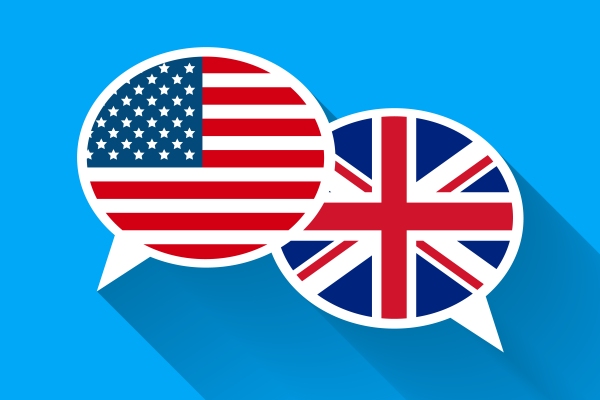Learning languages can be challenging – especially when we’re ambitious about it and acquiring just the basic skills is not enough. Discovering dialects can be surprising; Norwegian is particularly sneaky with this, as it can sound entirely different depending on the region you are visiting. Hence, being familiar with one dialect does not guarantee effortless communication anywhere else in the country. And how are things with English? Fortunately it’s not so complicated!
In the case of English, we can distinguish two main, basic varieties: British and American. And even though the accents can be quite messy and the attempts to comprehend and communicate with a native Scottish person can be discouraging for beginners learning English, the basic rules of the language remain the same and the differences will not be noticeable until much later during our language learning journey. There are, however, instances when this difference is crucial, e.g., when rendering localisation or proofreading services.
British English: what are its distinctive features?
So what is the easiest way to recognise we’re handling a text written using British English? A quick glance at words such as colour, aesthetics, demeanour or paediatric will tell us all. Color, esthetics, demeanor and pediatric are their American equivalents, so it’s easy to notice that British English stays closer to tradition and the original spelling of words borrowed from other languages, such as French, German, or Latin.
The use of “s” instead of a voiced “z” in verbs such as specialise, utilise or apologise is another characteristic of British English. They might be pronounced the same way, but the spelling is rather sneaky. A similar pattern can be observed with more complex words, such as British draught – in the American variety they are significantly simplified, as on the other side of the pond we will see it spelled as draft.
For many the British pronunciation is synonymous with that of the Royal Family; it’s worth knowing that you are unlikely to hear RP, received pronunciation, on a daily basis. There are over forty dialects being spoken in the United Kingdom, plenty of whom are starkly different to the language used in the recordings provided during language courses. The first clash with effortless, spoken language can be stunning, but it’s good to remember that encountering various dialects enforces attentive listening and fosters the attempts to comprehend the language, which translates into faster and better results of language learning.
American English – how is it different from the British variation?
So let’s move across the Ocean and check what are the most distinct features of the American variation of English. As we have mentioned earlier, the British are more likely to keep the original spelling referring to the origin of the words whose etymology can be traced back to other languages. The Americans are way more pragmatic, usually choosing to spell the words the way they are pronounced. That’s why they are written in a less complicated version, being closer to the way they are spoken.
And what are the characteristics of the American accents that could be recognised in recordings? First of all, look out for the characteristic “r” sound accompanying the pronunciation of particular vowels. We call them r-colored, as they are literally colored by the sound of “r” which is nowhere to be heard in the British variation. It can be clearly noticed in words such as butter, nurse, water or bar. Similarly as in the United Kingdom, we will hear a significant difference in English spoken by people in the American South and – for example – those from New England.
Mid-Atlantic accent is a curious thing – it is a blend of the most desirable characteristics of British and American pronunciation. It can be heard in movies such as “Breakfast at Tiffany’s”. Besides the usage in the film industry, it was also taught at elite schools.
Not only pronunciation and spelling – a few words on differences in meaning across the varieties of the English language
Differences between British and American English don’t end at spelling and pronunciation only (though these two issues alone can prove to be quite a thing to handle – ensuring a text is consistently written in one variety is often challenging). One of the most popular examples features the names of… snacks. American chips aren’t at all what a British person would understand when hearing about it – for them these are what Americans call French fries. Sports isn’t also universal across the cultures, as your conversation about football might not at all revolve around a game where you can use your feet only. To discuss it in the States, we would use the word soccer. While looking for a new place to call home, the British will seek flats, while the Americans will type apartment into their search bar. It’s not the only difference when it comes to real estate issues: while choosing a new spot, bear in mind that the British first floor is literally located on the first floor – but in the States, it can be as well located lower. If you’re not a fan of stairs, you’re going to be better off looking for a place on the ground floor.
Does it really matter?
While noticeable as we talk to someone using a different language variation, these differences don’t make it impossible to effortlessly communicate. Native speakers are well aware of the other names and while their meaning can sometimes lead to hilarious mistakes, it sure does not cause catastrophic errors or crushing financial losses.
It definitely matters when it comes to marketing content or official documentation handled on a given market – in such cases it’s worth to take extra care and pay attention to language consistency. While preparing such content, choose the variation of English used by your target readers. A team of translators, proofreaders and native speakers cooperating with Alingua is comprised of specialists sensitive to linguistic nuances, always ready to precisely tailor the text to our client’s needs.





